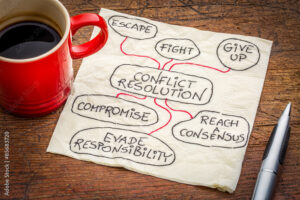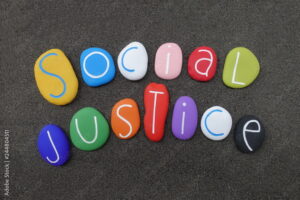Teachers as Curators and Guides
Schools are spaces of inclusion that endeavor to address sensitive topics by teaching students critical thinking and problem solving skills. Students need these important skills because they aid in navigating an often difficult and confusing world. From a young age, students will engage in conflict. This conflict begins to play out in social settings where they will move from the safety and comfort of the home to places like daycare and kindergarten. While not something that we want to enter into on a daily basis, conflict is a natural part of life. Inherently, conflict is neither good nor bad, it just sort of is, and exists in all we do. Coworkers may find themselves engaged in healthy discourse surrounding an upcoming election, or parents may be challenged by their teenage child who wants to borrow the car to head to a party. Whatever the scenario, it is important that we prepare our students to participate in healthy discussions that allow for the sharing of different ideas and opinions.
Students are learning in ways unfamiliar to many of us. The advent of social media and a 24 hour news cycle has drawn attention to issues that might have otherwise gone unheard or unnoticed. Students are exposed to controversial issues and must be offered opportunities to learn about them and formulate an intelligent, informed, and coherent understanding. Educators can act as curators of information and use current events topics to teach students how to sift through legitimate and valuable information and disregard outdated, exclusionary, and intolerant beliefs.
Perhaps one of the strongest criticisms of social media is how it makes misinformation widely accessible. The idea of fake news was not invented by Donald Trump, but it became a widely used catchphrase of his campaign and eventual presidency. More recently, the revelation that China influenced the 2021 Canadian federal election refocuses the discussion around truth on the internet. While people’s political beliefs run the spectrum, divisive rhetoric does little to promote a decent and thought-provoking conversation. More than any time in recent memory, emotionally charged topics dominate headlines, and in many ways it is near impossible to ignore these issues.
A Matter of Professionalism?
It is important that educators adhere to their professional mandate to teach students without intertwining their personal views. In doing so, students are able to formulate their own ideas and opinions and become well-rounded and informed citizens. However, the polarizing nature of the world and the advent of social media make doing so much more challenging. The issue of teacher neutrality is a century old debate. As Lawrence E. Metcalf discusses in his 1952 article, Must Teachers be Neutral? it is difficult for teachers to be truly unbiased concerning matters of personal belief. He sees this dualism as a perpetual conflict in which teachers attempt to walk a tightrope between their personal and professional life. Taryn Bond addresses this in her article suggesting ways to remain neutral in the classroom. She offers that teachers can talk about controversial subjects, remain neutral, and offer students critical thinking skills. Teachers cannot be afraid to turn it back to students and ask probing questions, especially when they give controversial responses.
Social Media and Professionalism
Complicating the matter of politicizing classrooms, is the debate around public professionals and their expectations on public forums like Instagram, Twitter, and Facebook. Professionally speaking, teachers are teachers at all times of the day and in all spheres. However, what does this mean for possessing a personal identity outside of traditional work hours. Teachers are human too and partake in the odd adult beverage, some may partake in use of marijuana considering its legal for consumption, should moments like these be documented? Conversely, some may take to social media to But how much is too much to share, and when should teachers get called to question? Torrey Trust responds to some of these questions in a short but thought provoking article in which she argues that educators should forge a social media presence. This might be a scary thought for some but ultimately allows for knowledge attainment and greater engagement with students and their interests.
Ultimately, teachers have professional standards to adhere to. Active participation in the profession requires teachers to check their personal beliefs in favour of unbiased learning. However, this does not mean that the classroom is not a place in which civil debate and discourse can take place. Contrarily, classrooms need to be places where students have opportunities to engage with real world issues- some of which may be controversial.
The Social Justice Classroom
In her article Teaching Social Justice in Theory and Practice Caitlin Clarke posits that classrooms need to be safe spaces where students feel empowered to share their thoughts and ideas on a topic…even if it’s controversial. One way she offers that teachers do this is by setting guidelines and rules for engagement in which students have space to share ideas in non-judgmental ways. Teachers can model responses so students hear how thoughtful commentary enrichens discussion.
Approaching social justice issues is daunting especially in small Saskatchewan towns where ideals are deeply engrained in the community psyche. Racism, sexism, LGBTQ+ rights, socio-economic disparity, bullying, dating, addiction, etc. are heavy topics, but in reality, these are issues that affect all of our students and preparing them to engage in informed ways is vital to promoting social justice rights outside of the classroom. It is our responsibility as educators to use powerful tools like social media to draw attention to hard topics. We don’t have to compromise our professionalism but we can create learning environments in which students learn to interact and communicate in appropriate ways.



“Whatever the scenario, it is important that we prepare our students to participate in healthy discussions that allow for the sharing of different ideas and opinions.” Jeff, I appreciate this comment. I think it’s so easy to get distracted by the trolling in the comments of any sort of media post about social justice issues (or really, literally any post). I think I have commented this in past blogs earlier in the semester, but I agree that a huge part of our job needs to be teaching kids about fair and reasonable discourse. And, even moreseo, we need to teach kids that it’s ok to disagree with someone — it is possible to do so in a really respectful way, and for us each to gain some learning!
Jeff,
I absolutely agree with your statement of needing to prepare our students for healthy conversations. If we avoid these topics and don’t give our student the opportunity to explore and try, then we aren’t bettering them. Children will eventually turn into working adults & communication will be a skill used in almost all aspects of our lives.
I also agree with letting our students figure out their own thoughts & opinions without having an influence from us teachers. I really enjoyed reading your post this week.
– Kennedy